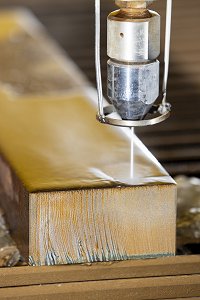Cutting faster, thicker and with higher precision
21.04.2020
With the development of ever new materials, manufacturers are automatically faced with the question of how to process them. The cutting process developed by ANT Applied New Technologies AG using Water Abrasive Suspension frequently proves to be an economical all-rounder offering unique properties and possibilities.
 In many industries, materials research regularly develops new materials for which suitable machining processes must be found. The spectrum ranges from new types of ceramics and glass to high-performance metal alloys, modern composite materials and plastics. For a large number of these materials, cutting with Water Abrasive Suspension (WAS) cutting jet is a technically superior and cost-effective machining process. In some cases, waterjet cutting is even the only option.
In many industries, materials research regularly develops new materials for which suitable machining processes must be found. The spectrum ranges from new types of ceramics and glass to high-performance metal alloys, modern composite materials and plastics. For a large number of these materials, cutting with Water Abrasive Suspension (WAS) cutting jet is a technically superior and cost-effective machining process. In some cases, waterjet cutting is even the only option.
Microstructure unaffected
Most cutting and parting processes generate heat, which can influence the properties of the materials. This applies especially to laser and plasma cutting, but also to machining with a geometrically defined cutting edge. In metals, for example, a structural change can affect the hardness or cause discoloration of the material. Cutting with WAS, on the other hand, does not generate any heat. Accordingly, the properties of the material are preserved after machining. Nor does cutting with WAS jet lead to hardening, tensions or material deformations.
Avoiding delamination
Composite materials can also be processed easily using the ANT technology. In general, these materials are considered difficult to machine due to their different layers. This can lead to fraying of the edges during various machining processes. The separation of the layers from each other, the so-called delamination, is also a recurring problem. With the WAS process, these problems can be easily avoided by fine-tuning the cutting jet and adjusting the water pressure.
Cutting depth up to 1000 mm
 The WAS process is similarly powerful when it comes to material thickness. Thanks to the air-free water jet, ANT's innovative process makes previously unattained cutting depths possible. Thicknesses of up to 1000 mm are possible with an excellent surface structure. Even with enormous material thicknesses, the cutting system only works at a maximum pressure of 1500 bar, which results in less wear and lower energy consumption.
The WAS process is similarly powerful when it comes to material thickness. Thanks to the air-free water jet, ANT's innovative process makes previously unattained cutting depths possible. Thicknesses of up to 1000 mm are possible with an excellent surface structure. Even with enormous material thicknesses, the cutting system only works at a maximum pressure of 1500 bar, which results in less wear and lower energy consumption.




































